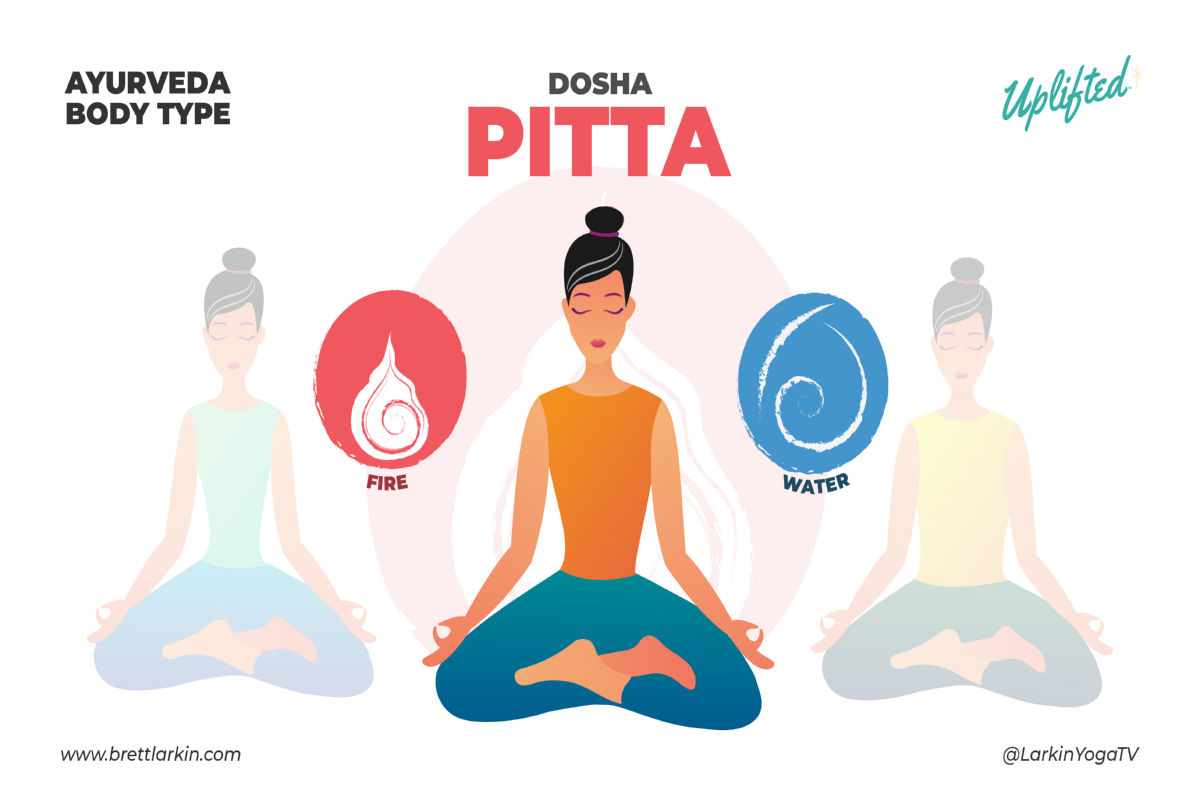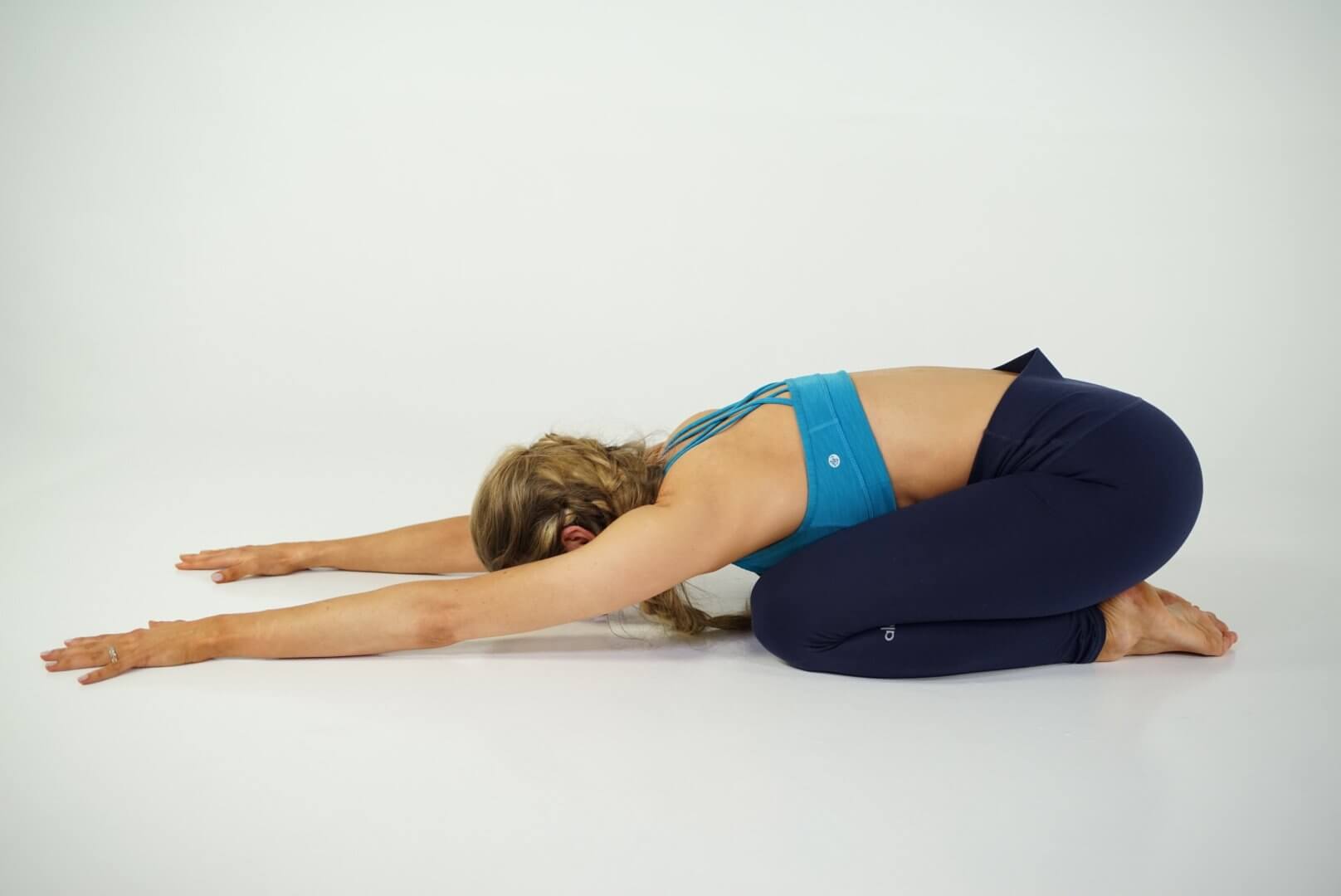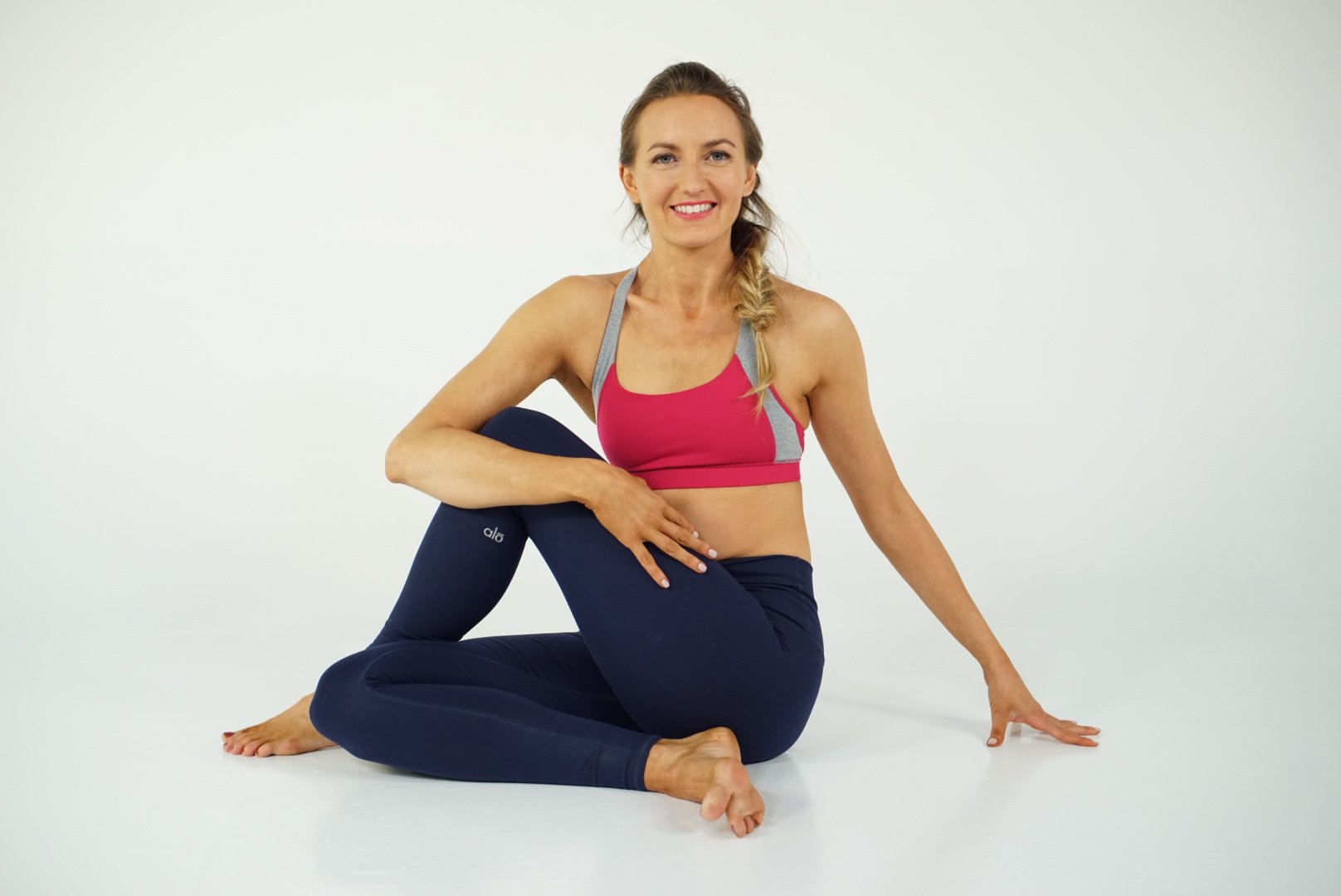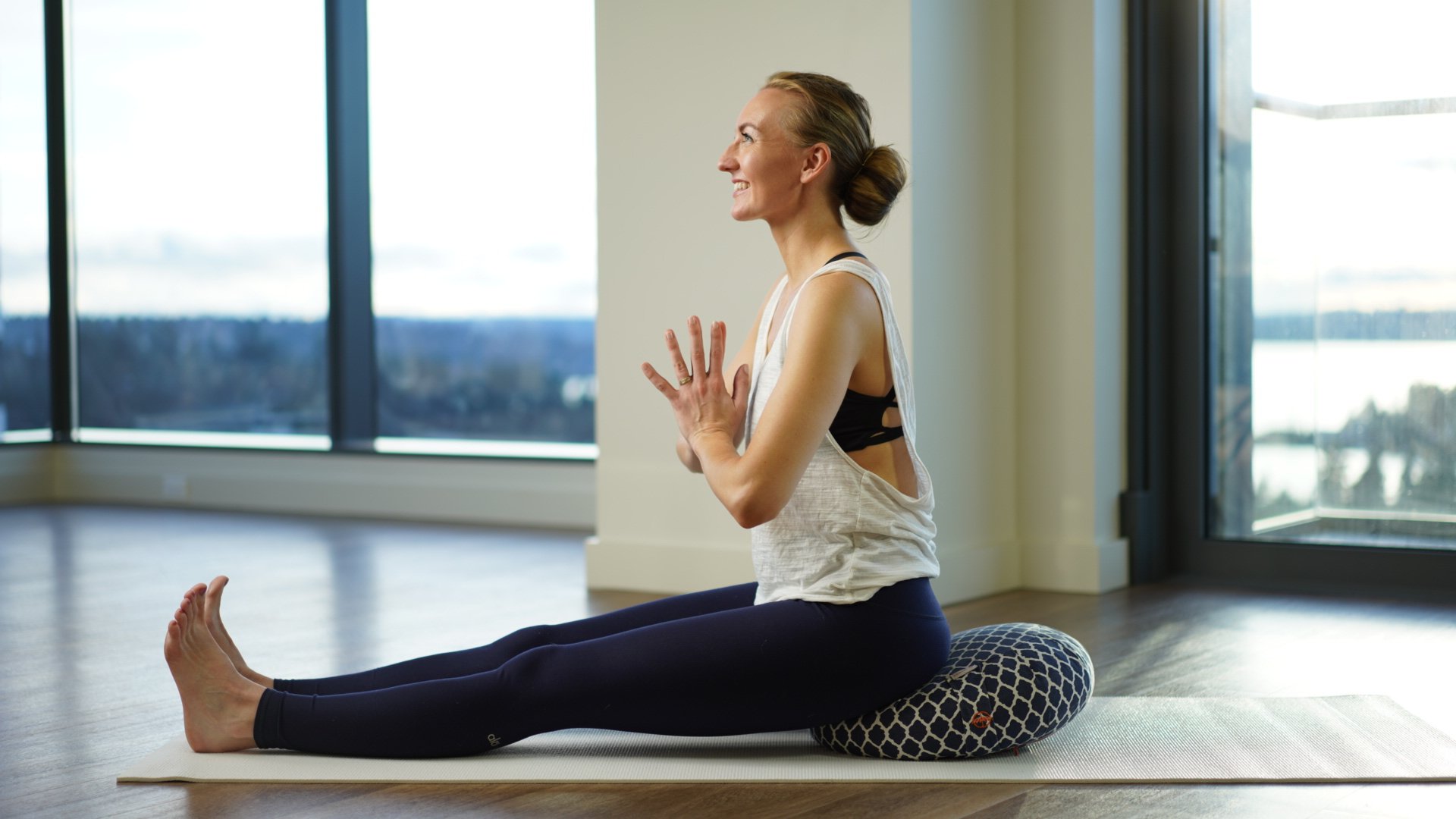Wanna know the best kept secret about yoga?
You can personalize your practice to balance your unique energy (AKA dosha).
What does yoga for pitta dosha look like?
It means on a day when you’re feeling ultra-tired, you can revive yourself on the mat. Or when you have jitters about that upcoming work event, you can find soothing in your practice. Depending on what you need, day to day, yoga can get your energy into a balanced state.
The best way to balance your energy is by using the ancient knowledge from yoga’s sister science, Ayurveda. According to this ancient wisdom, we each have three elements present in our body and mind, also known as doshas: Air (Vata), Fire (Pitta), and Earth (Kapha).
Together, these three elements make up your personal constitution, with one being dominant. Think of this like your astrology sign. If fiery Pitta is your predominant dosha, then you’re in the right place.
Don’t know your dosha? No worries! Take my quiz to find out what your dominant dosha is! Also, an ayurvedic practitioner can help you go deep into your unique constitution.
Let’s learn how to cool your fire and practice pitta balancing yoga, so you can be your best, most authentic, most joyful self.
Yoga for Pitta Doshas
Basic Guidelines: Get to Know Your Pitta Fire
If you’re a fiery Pitta, like me, then lack of motivation is rarely a problem for you. You’re an outstanding leader, with enough energy to power a thousand suns. Because of all your internal fire, you might even avoid hot weather and prefer cooler climates. You have enough heat inside!
Going on a day trip? You’ve already got a full agenda planned, down to the minute. You’re efficient, methodical, and the Queen of Getting Stuff Done. You love talking over listening, and doing over being.
In essence, you’re the ultimate high-achieving go-getter—and that is something to celebrate! However, being in go, go, go energy all the time can leave you feeling anxious, frazzled, and out of balance if you don’t learn how to douse your fire from time to time and let yourself rest.
When Pitta Dosha Is In Balance
When you’re in balance, nothing can stop you. You’re the magnetic leader that everyone else knows they can rely on. You can handle the pressures of life and bring balance to any situation through your decisive, action-oriented approach.
Practicing yoga helps you dispel any excess heat so you can stay your most charming, glowing self.
Sounds ideal, right?
Because you have so much fire in your belly (literally), your main goal to stay in balance is to release excess heat.
How do you know it’s time to get balanced? Well, there’s a few signs that will tell you that you need to hit the mat, ASAP…
When Pitta Dosha Is Out Of Balance
When you see yourself shifting from capable and “on fire” to a fire-breathing dragon, it’s time to get that Pitta dosha in check.
Here’s what to look out for:
Excess Pitta Symptoms
If you’re feeling any of these symptoms, you’re dealing with a Pitta imbalance and need to get rid of some excessive heat:
- Irritability
- Impatience
- Judgemental
- Controlling
- Anxious
- Fearful
- Easy to anger
Pitta’s Greatest Challenge
Your greatest challenge with all that fire element is to learn how to let go. To give up control and just be. To put down your to-do list and go have some fun.
Pitta pacifying yoga is your answer. An excessive Pitta dosha happens to the best of us—and luckily, there are yoga poses that will bring you right back into balance.
Balancing Yoga For Pitta Dosha
Pitta pacifying yoga will help you get back in balance. Think more restorative poses, less standing poses. More corpse pose, less sun salutations.
Typically, you probably love the fast-paced flows that get your heart-pumping. And that’s cool! Keep it up, but try to add some more soothing, restorative, relaxing poses to the front and backend of your practice too.
You don’t have to ditch your favorite standing poses completely—but you can practice pitta dosha yoga that gives you both what you want AND what you need.
Here are a few of my favorite poses for balancing pitta that you can incorporate into your daily routine…
Yoga Postures to Cool & Soothe Pitta Dosha
The yoga poses below are meant for balancing pitta. The last thing you want to do is increase heat. Instead, you want your body to reduce stress through the calm, cooling effects of poses which help you release heat. Any Pitta will benefit greatly from incorporating these asanas into their yoga practice.
First and foremost, when in doubt, forward folds, like Child’s pose, are your best friend. Standing and seated forward bends should be in every single practice. These fundamental poses are like a soothing balm for your nervous system. Make forward bends a key component of your asana practice and I promise you’ll notice a difference. Add several rounds of a cooling breath and you’ll want to practice your asanas 24/7.
To reduce the heat and take it one step further, pitta doshas should try these poses:
Ardha Matsyendrasana (Half Lord of the Fishes Pose)
If you’ve been sitting at a computer all day, this is the shoulder opener for you. Even Pittas can need a refresh, and a seated twist can gently energize you, while giving you an opportunity to stretch your outer hips and release low back tension.
For Pitta body types, the challenge in this pose will be not to strive to twist more. Simply allow yourself to naturally twist, and stay with the pose. This can become a core part of your yoga practice: learning to be, instead of push.
Ardha Matsyendrasana (Half Lord of the Fishes Pose) Instructions:
From Seated, twisting to the right:
- Take the right sole of your foot to the outside of your left thigh.
- Bend your left knee so that the sole of your left foot is next to your right hip.
- Breathe in and reach your arms up. Find length in the spine first, facing forward.
- Exhale, and use your core strength (not your arms!) to power the twist.
- Hug your right knee inside your left elbow. Place your right hand behind you.
- As you breathe in, find length. Get taller imagining space opening between each of the vertebrae in your spine.
- As you breathe out, draw your navel in toward your spine, gently twist more deeply.
- Come back to center. Pause. Then, repeat on the other side.
If this is too tight on your hips, you can use a block, blanket or bolster. Or, keep your left leg extended long instead. Keep your right foot on the inside of your inner left thigh, with the sole of your right foot alongside your left knee.
Paschimottanasana (Yin-Style Seated Forward Bend)
Need a break between meetings? This is the perfect pose to try out.
In traditional yogic seated forward fold pose, most people start reaching for their toes, tensing their shoulders, and snapping into that competitive stretching mode (Pittas, I’m looking at you!) As a teacher, even when I encouraged students to avoid these things, the impulse to touch their toes was too strong. So, I now exclusively teach a more passive, Yin-Style Seated Forward Bend.
The only goal in this Yin posture is to let gravity take over. You don’t even need to be warmed up to do this pose. You don’t even need a yoga mat!
I suggest a 3 minute minimum for this pose, but for Pittas, try a full 7 – 11 minutes. You’ll thank me. If it feels like you’re not “doing” anything in this position, that’s the point. You’re just rounding forward. This technique uses the principle of traction to release tension in the head, neck and shoulders. It’s the ultimate exercise in discovering comfort within discomfort. Prepare to be amazed at how much taller you feel after.
Paschimottanasana (Yin-Style Seated Forward Bend) Instructions:
- From a seated position, extend your legs in front of you. You can put a blanket or pillow under your seat for more support. Be limp and let your legs roll out to the sides, so there is no energy in the legs whatsoever.
- Dip your chin into your chest and round forward. Place your palms on the floor alongside your knees, facing up. Picture your body like a puppet at rest. No striving to lean forward, just being.
- As you stay rounded forward, keep thinking “heavy head.” Reach your chin toward your chest. Over the course of 8 – 10 breaths, you’ll begin to feel a stretch somewhere along the neck or spine. Somedays, the stretch will be in your neck and head only. Others, it will be in the low or mid-back. The longer you hold the pose, it’s likely that where you feel the stretch will shift.
- Embrace complete stillness. Breathe into wherever you feel sensation.
Poses to Limit for Pitta Types
If you’re looking to soothe a particular dosha, like Pitta, then there are certain poses you’ll want to avoid. Anything in yoga that builds heat in the body is good for a pitta dosha within reason, because the main goal is to release heat.
Here are a few yoga poses that those with a dominant pitta dosha will want to limit:
- Hot yoga – you already have enough fire!
- Sun salutation
- Cat cow
- Tree pose
- Bow pose
- Cat pose
- Bridge pose
- Locust pose
- Cobra pose
- Practice heating postures like Warrior I, II and Chaturanga in moderation. These poses discharge your extra fire, but too much will take you further out of balance.
Off the Mat Tips for Soothing Pitta In The Moment
If you have a too much Pitta dosha moment while you’re off the mat, I’ve got two tips that you can practice anywhere, anytime. First, anytime you’re feeling your fire take over, bring in a cooling effect to calm things down. Take a cold shower, splash your face with cold water, or if you’re really stuck, visualize a freezing cold waterfall soothing you from the inside out.
Next, anytime you feel your sense of urgency taking control, remember to SLOW DOWN! Give yourself an unexpected break by taking a bath in the middle of the day or going for a walk in the afternoon. Cut out of work a little early and pop into the store you’ve been wanting to check out. Take breaks as frequently as you can, even if it’s only to pause for five minutes and lie down.
Finally, anytime you can get outside in nature and deepen your breath, you’re calming your Pitta. Your body will thank you for taking the time to soothe your nervous system. You might even want to incorporate some of these exercises into your spiritual practice, if you have one.
Your motto is: Move slowly and less is more. Try to remember this, instead of rushing through your day.
Final Thoughts
Understanding how to manage your dominant pitta dosha can help you utilize the benefits of Ayurvedic medicine and achieve optimal health. To go deeper, join the Uplifted Community or grab my new book YOGA LIFE to learn more.
Next Steps
- Take my History of Yoga Course to learn all about yogic principles and how they are applied to daily life!
- Order my Yoga Life book for a practical guide to applying yogic principles to your life and constitution.
- Check out my Yoga Philosophy knowledge hub for more inspiring content
- Join Uplifted for exclusive content that you can access right from the app. Take a deep dive into your practice with me this year!
Fall in love with my 200-Hour teacher training or …
Experience 3 Training Videos from Inside My 200-Hour Online YTT

YOU MIGHT ALSO LIKE
- My Homemade Immunity Tea Recipe For Winter
- How To Do An Ayurvedic Panchakarma Cleanse At Home (Safely)
- Ayurveda Food Combining: The Key to Balanced Digestion
- How To Reduce Body Heat According To Ayurveda
- Types Of Agni In Ayurveda And How To Balance
- How To Balance Doshas And Step Into Your Powerful Self
- The Eight Branches Of Ayurveda: Guide To A Happy Life
- Yoga for Vata Dosha: Practice Poses and Tips
- Yoga for Pitta Dosha: Practice Poses and Tips
- Yoga for Kapha Dosha: Practice Poses and Tips
- Jal Neti Kriya: The Best Thing You Can Do To Clear Your Head Right Now
- My Exact Ayurveda Morning Routine For Yogis
- The 6 Stages of Disease in Ayurveda
- Discover Your Ayurvedic Constitution and Balance Your Mind, Body, and Spirit
- Understanding the Basic Principles of Ayurveda for Yogis
- 3 BEST Ayurveda Schools for a Holistic Ayurvedic Certification
- What Are Nadis? Your Guide to Energy Channels In Your Body.
- What Is An Ayurvedic Diet? Foods For Your Doshas
- A Day Around the Doshas: What I Learned When I Followed the Ayurvedic Clock
















